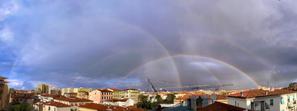Glossary term: 彩虹
Description: 彩虹是一種巨大的弧形或弓形,自內而外有著紫色、靛色、藍色、綠色、黃色、橙色和紅色的同心條紋,橫跨天空,通常在下過雨後才能看到。觀察者需要背對太陽才能看到彩虹。彩虹之所以出現,是因為空氣中的小水滴通過折射將白色陽光分解成彩色光譜,這個過程叫做色散,與三稜鏡的工作原理類似。在一般的彩虹中,陽光在水滴內不但通過折射而被色散,還發生了一次反射。
有時可以看到兩條套在一起的彩虹,第二條彩虹的顏色順序與第一條恰好相反。內側較亮的彩虹稱為主虹,外側較暗的彩虹稱為副虹(又稱為霓)。這種雙彩虹現象並不常見。當陽光在水滴內除了折射外還發生了兩次反射時,就會出現雙彩虹。
Related Terms:
See this term in other languages
Term and definition status: The original definition of this term in English have been approved by a research astronomer and a teacher The translation of this term and its definition is still awaiting approval
This is an automated transliteration of the simplified Chinese translation of this term
The OAE Multilingual Glossary is a project of the IAU Office of Astronomy for Education (OAE) in collaboration with the IAU Office of Astronomy Outreach (OAO). The terms and definitions were chosen, written and reviewed by a collective effort from the OAE, the OAE Centers and Nodes, the OAE National Astronomy Education Coordinators (NAECs) and other volunteers. You can find a full list of credits here. All glossary terms and their definitions are released under a Creative Commons CC BY-4.0 license and should be credited to "IAU OAE".
If you notice a factual or translation error in this glossary term or definition then please get in touch.
Related Media
彩虹的24小時
Credit: Fabrizio Guasconi/IAU OAE (CC BY 4.0)
License: CC-BY-4.0 Creative Commons 姓名標示 4.0 國際 (CC BY 4.0) icons
Related Activities
Reading the Rainbow
astroEDU educational activity (links to astroEDU website) Description: By understanding how rainbows work, you can discover about light and its properties, learning about stars, nebulae, galaxies, and our Universe.
License: CC-BY-4.0 Creative Commons 姓名標示 4.0 國際 (CC BY 4.0) icons
Age Ranges:
14-16
, 16-19
, 19+
Education Level:
Informal
, Middle School
, Secondary
, University
Areas of Learning:
Interactive Lecture
, Observation based
, Social Research
Costs:
Low Cost
Duration:
1 hour 30 mins
Group Size:
Group
Skills:
Analysing and interpreting data
, Asking questions
, Engaging in argument from evidence










